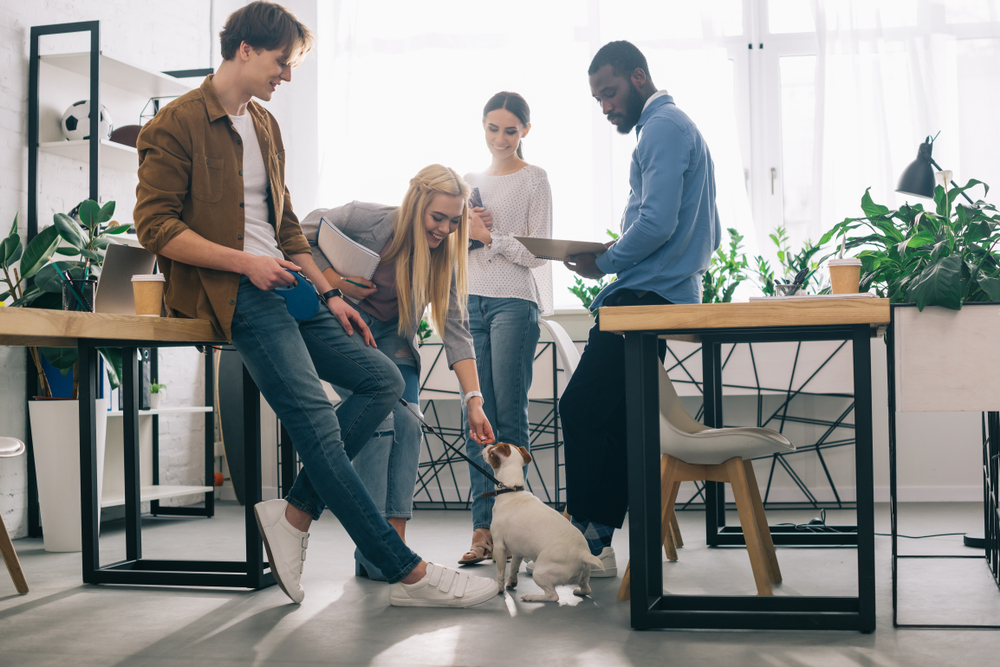Taking your dog to the office tomorrow? Some people are lucky enough to work for companies with dog-friendly office environments where well-behaved furry friends are welcome companions and coworkers. For everyone else, Take Your Dog to Work Day is an appreciated and highly anticipated opportunity to share workspace with canine companions.
Whether your dog has an open invitation to accompany you to work, or if he has a pass for a special occasion, like Take Your Dog to Work Day, here’s how to increase the ease and enjoyment of having him at your side as you work.
Establish Boundaries
Canine coworkers should be well behaved and well socialized. Dogs who become fearful, aggressive, or otherwise agitated around other dogs, people, noises, or unfamiliar situations are best left at home in their familiar surroundings. Taking your dog with you to work only if she’s likely to be adaptable and friendly in the work environment shows respect for your coworkers as well as for your dog’s wellbeing and safety.
Think Like a Dog
What’s at the office that your dog might consider threatening, upsetting, or exciting, causing him to be unable to remain calm? Sliding doors, slick floors, stairs, or elevators may all give your dog pause. Practice with your dog in these environments before the big day.
Familiarity Brings Comfort
Set up your work space with familiar items your dog enjoys such as a bed or blanket from home. Dogs who are crate-trained may appreciate the opportunity to retreat to their safe space. Make it more private with a crate cover or blanket placed over three sides of the crate. If your dog is supervised or confined to your office with a barrier such as a pet gate or door, leave the crate door open so your dog can move in and out freely.
Make plans for instances in which your dog may be unwelcome in the workspace, such as a big meeting with a client, lunch in the cafeteria, or a trip to the restroom. For those times when he needs to stay in your office, use a baby gate or playpen to confine him or close the door. Place a sign on the door advising passersby that your dog is inside so that no one accidentally releases your hound. (Don’t Disturb, Rover’s Resting). In addition, include your cellphone number or the specific space you’ll be in case you’re needed. A whiteboard or sticky notes allow you to update your whereabouts as needed.
A Calm Space
Consider playing calming music for your dog at a low volume, if doing so isn’t disruptive to coworkers. Species-specific music, reggae, classical music, and soft rock have all been shown to be calming for canines.
Pheromones can also calm dogs by chemically signaling safety and security. Spritz pheromones on bedding or a bandana 10 to 15 minutes before use and refresh every 4 to 6 hours.
Routine Rules
Just as at home, keep your dog to a regular schedule as much as possible. Provide ample opportunities for your dog to relieve himself outdoors. Don’t forget those poop bags, so that you can pick up where your pooch leaves off. It’s also a good idea, just in case, to bring accident cleanup materials such as paper towels and an enzymatic cleaner.
Keep Your Pooch Employed
Provide positive, productive work for your dog so that he doesn’t become frustrated and agitated because he’s bored. You don’t want him coming up with his own, not-so-productive “work assignments” such as barking at coworkers walking by.
Instead, give a food puzzle to harness his mental and physical energy. For highly skilled canine code crackers, offer a challenge in the form of a cavity toy with tasty treats frozen inside. Some dogs enjoy quietly “grazing” for kibble or healthy treats in a snuffle-type mat that engages the dog’s sense of smell. Dogs who come into the office frequently will benefit from a rotation of chew toys, reducing the likelihood that they’ll do some off-limits chewing of office furniture. Be sensitive to the workplace environment and needs of coworkers by bringing quiet toys and keeping excitement levels appropriately low.
Making Office Friends
Be courteous toward others who may not be as enamored of your dog as he is of them. People with allergies or an underlying fear of dogs may prefer to keep their distance. Leash your dog when walking through the workplace and make sure he stays in your workspace. Allow your dog to greet people only when the situation is appropriate and mutually enjoyable. Use your dog’s known behaviors, such as sit, down, or shake, to guide interactions in a positive way and reinforce your dog’s polite manners.
Without a doubt, having dogs in the workplace is an awesome opportunity that can be enhanced with preparation that promotes your dog’s success and enjoyment of the experience.
This article was reviewed/edited by board-certified veterinary behaviorist Dr. Kenneth Martin and/or veterinary technician specialist in behavior Debbie Martin, LVT.








